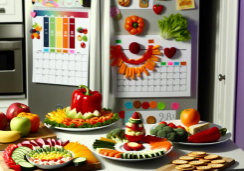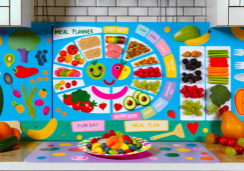Budget-Friendly Family Meal Planning: 14 Top Tips
Nearly 25% of your monthly income could be swallowed by grocery bills if you're not careful, but with strategic planning, you can significantly trim that expense. You know the drill: You aim to save money, yet somehow, after every supermarket trip, your wallet feels lighter than anticipated.
But what if you had a cache of practical, no-nonsense tips tailored to keep your finances in check while feeding your family well? That's where the art of meal planning comes into play. It's about more than just scribbling a shopping list; it's a thoughtful approach that, when done right, can transform your kitchen into a haven of cost-effectiveness.
Stay with me as I guide you through these 14 top tips that promise to streamline your meal prep process without sacrificing quality or flavor, and just maybe, you'll uncover the secret to keeping both your belly and bank account full.
Set a Meal Budget
Establishing a specific meal budget is a crucial step in managing your household's food expenses effectively, ensuring you can enjoy nutritious meals without overspending. To start, you'll want to assess your current grocery expenses, considering the nutritional needs of your family, and then set a realistic grocery budget. This foresight doesn't just help save money; it also helps you save time by avoiding last-minute shopping trips that can lead to impulse buys.
To make your budget work harder, keep an eye out for coupons, discounts, and sales. These can significantly lower your expenses, allowing you to allocate funds towards higher-quality, nutrient-dense foods. As food prices fluctuate, adjust your budget and meal plans accordingly. Incorporating cost-effective ingredients doesn't mean compromising on nutrition; many budget-friendly items like beans, lentils, and in-season vegetables are both nutritious and economical.
Involve your kids in the planning process too. This teaches them the value of money and helps them understand the importance of making healthy choices on a budget. By doing so, you're not just planning meals—you're also instilling lifelong habits that will benefit their future.
Plan Weekly Menus
After setting your meal budget, it's time to create weekly menus, a strategy that not only maximizes your dollars but also ensures your family enjoys a variety of nutritious meals. Crafting your meal plan hinges on a balance of nutritional needs and budget constraints.
Start by scouring store ads for deals that can guide your menu choices, ensuring you're getting the most bang for your buck without compromising on healthy options.
Before you jot down your grocery list, take stock of what's already in your fridge, freezer, and pantry. You'll waste less and might find inspiration for meals that include ingredients you already have. This step can also prevent overbuying, which is both economical and sustainable.
Incorporating a meal plan into your routine helps you sidestep the temptation of fast food on busy nights. Knowing what's for dinner each evening alleviates the stress of last-minute decisions and keeps you on track with your nutritional goals.
For added convenience, consider using online ordering systems to stick to your grocery list and avoid impulse purchases. This method streamlines the process, making it easier to adhere to your meal plan and manage your budget effectively.
With a well-thought-out menu and a clear grocery list, you'll be all set for a week of healthy, budget-friendly meals.
Shop Sales and Discounts
Regularly scanning store ads for sales and discounts can lead to substantial savings on your grocery bills while still maintaining a nutritious diet. As you peruse the weekly flyers or digital promotions, keep an eye out for deals on lean meats. When you find a good sale, stock up and portion the meats for freezing, ensuring you have quality protein options for future meals at today's lower prices.
In the grocery store, don't just browse the front displays in the produce section; venture deeper to compare prices. Often, the best bargains on fruits and vegetables are tucked away. By doing so, you're not only saving money but also incorporating a variety of nutrients into your family's diet.
Embrace technology and clip digital coupons which can be easily accessed through store apps or websites. Also, sign up for grocery store loyalty programs to receive additional discounts exclusive to members. These programs often provide personalized deals based on your shopping habits, which can further optimize your savings.
When you shop, stick to your list but remain flexible enough to substitute items with those on sale, prioritizing the sales and discounts to maximize your budget without compromising nutritional value. Remember, smart shopping is about balance: saving money while nourishing your family.
Buy in Bulk Wisely
When you're planning your family's meals, buying in bulk can be a smart way to save money, but you need to do it wisely.
You'll want to identify deals on items that you regularly use and ensure you can store them properly to prevent waste.
Be mindful of bulk buying pitfalls, such as purchasing more than you need or buying items that aren't nutritionally beneficial just because they're on sale.
Identifying Bulk Deals
To smartly stock your pantry, identify bulk deals on nutritious staples, keeping an eye out for discounts on alternative proteins and in-season produce.
When grocery shopping, consider alternative protein sources like beans or tofu, which not only offer variety but are often less expensive than meat and poultry. If you prefer meat, look for deals or coupons to maximize savings without compromising nutrition.
Assess the seasonal produce calendar as fruits and vegetables in their peak season tend to be more affordable and flavorful. Frozen fruits and vegetables can be smart, budget-friendly choices, offering the same nutritional benefits as fresh options.
Always compare prices across stores when buying in bulk to ensure you're getting the best value for your money.
Storing Bulk Purchases
After securing the best deals on bulk purchases, it's essential to store them properly to maintain freshness and nutritional value. Here's how you can ensure your food lasts longer than fresh and remains as nutritious as possible:
- Divide and Conquer: Immediately portion family-sized packs and freeze half for later use, preventing waste and preserving quality.
- Seasonal Savvy: Buy fresh produce in season and store it correctly; some items last longer in a cool, dark place, while others need refrigeration.
- Frozen Finds: Embrace frozen fruits and veggies—they're picked at peak ripeness and flash-frozen to lock in nutrients.
- Herb Haven: Grow herbs at home; they're simple to maintain and can be dried or frozen for long-term use.
Bulk Buying Pitfalls
While buying in bulk can trim your grocery bill, it's crucial to avoid common bulk buying pitfalls such as purchasing more than you need or choosing items high in added fats, sugars, and salts.
Be wary of impulse buys that seem economical but may lead to waste or unhealthy eating habits.
Opt for family or value size packs of meats and poultry, and consider freezing unused portions to extend their shelf life and save money.
Always be on the lookout for deals or coupons to maximize savings.
For a healthier twist, consider alternative protein sources like beans or tofu, which aren't only cost-effective but also nutritious.
Remember to scrutinize labels for added fat, sugar, and salt, especially in processed meats, to ensure your bulk purchases align with your family's nutritional needs.
Embrace Seasonal Produce
Incorporating seasonal produce into your meal planning not only enhances flavor but also significantly cuts down on food costs. When you buy what's in season, you're not only getting the freshest flavors but also supporting a more sustainable food system. As fruits and vegetables grow in abundance during their peak seasons, prices tend to drop, making it easier for you to fill up your cart with nutritious options without breaking the bank.
Here's why you should make seasonal produce a staple in your kitchen:
- Peak Flavor: Fresh fruit and vegetables taste better when they're picked at the height of their season.
- Nutrient Rich: Seasonal produce often contains more nutrients, as it hasn't spent a long time in transit or storage.
- Cost-Effective: Abundant supply usually means lower prices, so you'll save money while stocking up.
- Variety: Rotating your menu with the seasons prevents mealtime monotony and inspires creativity.
Cook Once, Eat Twice
Building on the cost-effectiveness of seasonal produce, the 'Cook Once, Eat Twice' method further maximizes your meal planning efficiency by transforming tonight's dinner into tomorrow's lunch. When you make enough food for two meals, you're not just saving time, but also ensuring that your family is getting the most out of each cooking session.
For instance, roasting a larger batch of leftover chicken can provide the protein for a hearty dinner and the base for a nutritious chicken salad the next day.
This approach is anchored in the principle of intentional leftovers. By planning to cook larger quantities, you're making a conscious decision to repurpose your meals. It's not just about reheating what's left; it's about reinventing it to maintain variety and interest.
This strategy is also a win for nutrition—it encourages you to think ahead about balanced meals over multiple days, maintaining a focus on including a variety of food groups.
Opt for Generic Brands
Switching to generic brands for your pantry staples can trim your grocery expenses without compromising on quality. When you're making your grocery shopping list, remember that store brands offer significant cost savings and are often just as nutritious as their name-brand counterparts. By choosing generics, you're not only being budget-savvy but also maintaining the nutritional value of your meals.
Here's how opting for generic can make a positive impact:
- Increased Savings: Every dollar saved on generics means more money for fresh produce or even family treats.
- Comparable Quality: Store brands have to meet the same food safety and quality standards as name brands.
- Broad Selection: From spices to cereals, there's a generic option for nearly every item on your list.
- Smart Shopping: You're making informed choices that benefit your wallet and your family's health.
Embrace the generic brands in your grocery aisles. They're a smart choice that aligns with a nutrition-focused, evidence-based approach to eating well. By doing so, you'll find that your grocery bill shrinks while the quality of your family meals remains reliably high.
Grow Your Herbs
You can enhance your meals nutritionally and gastronomically by learning the basics of herb gardening. Maximizing your herb harvests ensures you'll always have a supply of fresh flavors to add to your family's diet, offering both health benefits and cost savings.
Even if you're tight on space, indoor herb gardens can thrive on a sunny windowsill, making it easy to incorporate these nutritious plants into your meal planning.
Herb Gardening Basics
Kickstart your journey to healthier eating by setting up an herb garden in a sunny spot with well-draining soil, choosing easy-to-grow herbs like basil, mint, and parsley to enhance your meals. These fresh additions can transform your dishes, making healthy meals even more flavorful and reducing your reliance on pantry staples that may be high in sodium or preservatives.
Consider these steps for a flourishing herb garden:
- Select the Right Spot: A location that receives plenty of sunlight.
- Water Wisely: Allow the soil to dry out a bit between waterings.
- Harvest Often: Regular picking promotes growth and yields more herbs.
- Use Freshly Picked Herbs: Incorporate them into your cooking for maximum nutritional benefits.
Maximizing Herb Harvests
Building on the foundation of your herb garden, it's important to learn how to maximize your herb harvests to ensure a continual, fresh supply for your family's meals. When you plan for a family, incorporating a variety of herbs can significantly elevate the nutritional value and flavor of your dishes.
To save money and avoid waste, freeze leftover herbs in ice cube trays with water or oil. This method preserves their freshness for future meal planning. Additionally, drying excess herbs allows you to create homemade blends that can be tailored to your family's taste preferences.
Research each herb's specific needs to provide optimal growing conditions, and consider an indoor garden to keep your supply thriving year-round. Your efforts will enrich your meals with both taste and health benefits.
Use Leftovers Creatively
Transforming your leftovers into novel culinary creations not only curbs food waste but also stretches your budget with nutritious, reimagined meals. When you use leftovers creatively, you're making a positive impact on both your wallet and the environment. Imagine turning last night's roasted chicken into a savory filling for burrito bowls today. By repurposing what you already have, you give new life to what might otherwise be discarded.
Here's how you can get started:
- Revive Grains: Toss leftover rice or quinoa into a stir-fry or a warm salad. It's an easy way to add fiber and substance to your dish.
- Protein-Packed Sandwiches: Utilize leftover meats or beans in sandwiches or wraps. They provide a good source of protein and make for a fulfilling lunch.
- Innovative Casseroles: Mix leftover pasta with some veggies and a protein to bake a comforting casserole that's both balanced and delicious.
- Egg-cellent Breakfasts: Stir leftover vegetables into a frittata or scramble for a nutrient-rich start to your day.
Batch Cooking Strategies
Just as repurposing leftovers can maximize your meals, batch cooking is another effective strategy to manage your food resources wisely, ensuring you have healthy, home-cooked options on hand. By investing a bit of time in meal prep, you can create an array of dishes that cater to your family's nutritional needs and taste preferences, while also being mindful of your budget.
When you buy family or value size packs of meat, consider dividing them into the portions you'll use for meals and freeze what you don't need immediately. This approach takes advantage of bulk pricing without letting any food go to waste. Similarly, keep an eye on what fruits and vegetables are in season; these aren't only more flavorful but also more affordable. You can freeze them to extend their shelf life and enjoy their freshness later.
Incorporate sheet pan dinners into your batch cooking routine for a simple, nutritious meal that requires minimal cleanup. These allow you to cook proteins and veggies together, and the variety of combinations can prevent mealtime monotony.
Reduce Meat Consumption
Cutting back on your family's meat consumption can be beneficial for both your health and budget, especially when you incorporate alternative proteins like beans or tofu into your meals. By choosing these alternatives, you're not only saving money but also embracing a diverse range of nutrients that can enhance your family's diet.
Here's how you can effectively reduce meat consumption:
- Choose Budget Proteins: Swap out more expensive meats for cost-effective chicken thighs or ground beef in your recipes. They're versatile and can be stretched further in dishes like casseroles or stir-fries.
- Meatless Mondays: Dedicate one day a week to vegetarian meals. It'll give your wallet a break and introduce your family to new flavors and nutrients.
- Bulk Buys: Purchase larger packs of meat when they're on sale and freeze what you don't use. This approach allows you to enjoy meat in moderation without overspending.
- Seasonal Shopping: Focus on seasonal fruits and vegetables for savings. They're packed with flavor and can stand in for meat in many dishes, giving you a nutritional boost.
Store Food Properly
Storing your food properly can dramatically increase its shelf life, ensuring you get the most out of every grocery trip. By organizing your fridge into zones and understanding which foods benefit from cooler or warmer sections, you'll prevent spoilage and maintain optimal freshness.
Remember to freeze surplus cooked meals and label them with dates to make future meal planning a breeze while minimizing waste.
Maximize Shelf Life
To ensure your groceries remain fresh and nutritious for as long as possible, it's crucial to store them correctly, utilizing methods that extend shelf life and prevent waste. Here are some evidence-based tips and tricks to maximize shelf life:
- Label and Date: Keep track of what's in your freezer by labeling and dating items. This simple step can evoke a sense of control and accomplishment.
- Proper Defrosting: Defrost frozen items correctly to maintain their quality. This method ensures your meals are always delicious and safe.
- Strategic Storage: Store foods in their ideal conditions. This practice showcases your commitment to your family's health.
- Freezer Utilization: Use your freezer to preserve fruits, vegetables, and leftovers. Embrace this tip as a smart strategy to protect your budget and the planet.
Organize Fridge Zones
Have you ever wondered how organizing your fridge into specific zones can extend the freshness of your groceries and cut down on waste? When you store food properly, you're not just keeping it fresh—you're also supporting your meal plan efforts.
Use the refrigerator door for condiments and beverages, as these areas are less cold. Reserve the main shelves for perishable items like dairy and deli meats, ensuring they stay at the optimal temperature.
Your crisper drawers are ideal for fruits and vegetables; just keep them separate to prevent premature ripening. For your Instant Pot creations and other leftovers, use transparent containers on the upper shelves so they're readily visible and reachable.
Prevent Food Spoilage
Properly managing your pantry and refrigerator can significantly reduce food spoilage, ensuring that every item you've purchased is used to its full potential and supports your nutritional goals. As you implement meal plans, make sure to:
- Prioritize Perishables: Use foods with the nearest sell-by dates first to prevent waste.
- Freeze the Surplus: Preserve excess fruits, vegetables, and leftovers by freezing them.
- Opt for Frozen Produce: Choose frozen fruits and vegetables, which are cost-effective and retain their nutrients.
- Label and Date: Always mark items in the freezer with their contents and the date they were stored.
Limit Dining Out
Cutting back on dining out not only supports your health goals but also keeps your budget in check, and planning meals to include batch cooking and versatile ingredients can be a game-changer.
When you create a meal plan for your family, focus on recipes that yield enough food for multiple meals. Leftovers can save the day when time is short, and the temptation to hit the nearest restaurant looms.
Versatile ingredients are your allies in this endeavor. Stock up on items that can be repurposed across various dishes throughout the week. This strategy reduces the urge to order takeout on a whim, ensuring that you have the components for a home-cooked meal ready to go.
Rethink your protein choices as well. Alternative sources like beans or tofu aren't only cost-effective but also nutritionally rich, offering a break from traditional, often more expensive, meat options.
Involve the Family
While reducing the frequency of dining out can significantly benefit your budget and health, actively involving your family in the meal planning process can further enhance these advantages. For a family of four, it's not just about saving money; it's also about fostering healthy eating habits and teamwork. Here's how you can involve the family:
- Invite Creativity: Let each member suggest a meal idea for the week. This not only diversifies your menu but also gives everyone a sense of contribution and anticipation.
- Share Responsibilities: Rotate cooking duties or assign specific tasks to each person. This approach teaches valuable cooking and planning skills, especially for children.
- Plan Together: Hold a family meeting to decide on meals for the upcoming week or month. Everyone's preferences get considered, ensuring diverse, nutritionally balanced meals.
- Themed Cooking Nights: Establish fun themes for certain nights, like 'Taco Tuesday' or 'Stir-Fry Saturday'. These can be exciting events that the whole family looks forward to.
Frequently Asked Questions
How to Feed 9 People Cheap?
To feed nine people cheaply, you'll want to focus on bulk buying and meal prepping. Choose nutritious, whole foods and plan balanced meals that can stretch across several servings to maximize savings.
Is $200 a Month Enough for Groceries for One Person?
You can manage on $200 a month by coupon clipping and seasonal shopping, ensuring you're getting nutritious food while staying on budget thanks to smart strategies and disciplined spending choices.
How Do You Feed a Large Family Healthy Meals on a Budget?
To feed a large family healthy meals on a budget, you'll want to embrace meal prep and bulk buying. Strategize with nutritious, cost-effective ingredients to create balanced meals that are both satisfying and economical.
How Do You Feed a Family of 4 on $10 a Day?
You'll feed a family of 4 on $10 a day by using ingredient swaps, like beans for meat, and bulk cooking. This approach is nutritionally balanced and cost-effective, stretching your budget further.
Conclusion
Now you're equipped with 14 top tips to master budget-friendly meal planning for your family. Remember, balance and nutrition don't have to break the bank.
By setting a budget, planning around sales, and embracing smart shopping tactics, you'll nourish your loved ones without financial strain.
Keep meals varied with seasonal produce and less meat, and store food efficiently to minimize waste.
Involve everyone—it's a recipe for success that'll benefit your wallet and your family's health.
Make each meal count!










